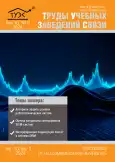Relevance: The work addresses the problems of broadband modulation in relation to multiple access problems. The advantages of code multiplexing in the process of expanding the signal spectrum are indicated, which, as shown in the work, is a promising method of parallel data transmission. Purpose: The purpose of this work is, firstly, to increase the efficiency of using address sequences to identify the sender and recipient of information; secondly, to organize a parallel data transmission process from one node to many, ensuring the anonymity of the recipient and, thirdly, maintaining a low peak signal factor. Statement of the problem: The objectives of the work include the selection of address code structures, which, at two stages of expanding the signal spectrum, should solve the issues of identifying senders and recipients of information in the network at the physical level. It is required to build a system model that will ensure parallel data transfer from one node to many. An important requirement in such a multiple access network should be the ability to use modulation with the lowest signal crest factor. Methods: This work proposes two-stage wideband modulation using the direct spread spectrum method, where each sending node first generates an equivalent Gold code as the sum of sequences of maximum length addressed to recipient nodes, and then uses an address sequence identifying itself from set of orthogonal signals. The paper proposes methods for processing spectrum-expanding sequences based on the dual basis of the Galois field, which make it possible to quite effectively isolate information intended for each recipient. Results: A model of a parallel data transmission system with multiple access based on two-stage spectrum expansion is proposed. Identification of senders and recipients of information is carried out by mechanisms for the formation of address signal-code structures at the physical level. It is possible to implement a model with anonymous recipients, when any of the recipient nodes does not have information about the data addressed to other nodes. Also, this model does not contradict the use of the most noise-resistant type of modulation BPSK (or QPSK in single-bit transmission mode), which is designed to provide an extremely low signal crest factor. Novelty: A fundamentally new method of addressing at the physical level for a network with parallel information transmission is proposed, which increases the efficiency of using the frequency range. Theoretical and practical significance: The results obtained in the work, in the future, can be used in the construction of various highly noise-resistant networks with multiple access, where an important requirement is, first of all, an extremely low crest factor of the data source signal. Such networks include, in particular, networks formed by swarms of UAVs.
 7-22
7-22


 24-34
24-34


 35-44
35-44


 45-58
45-58


 59-65
59-65


 66-73
66-73


 75-86
75-86


 87-103
87-103


 104-115
104-115


 116-126
116-126







